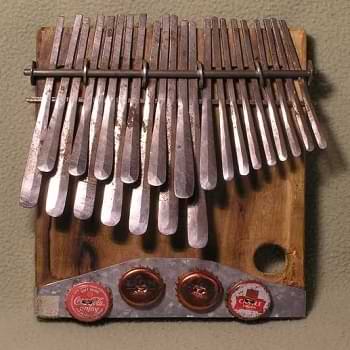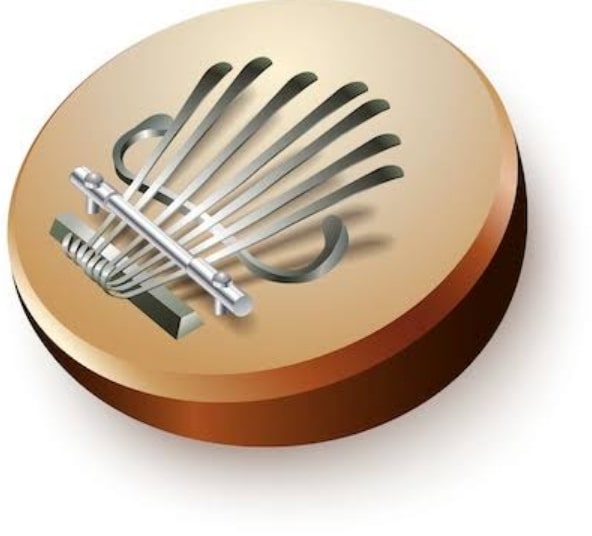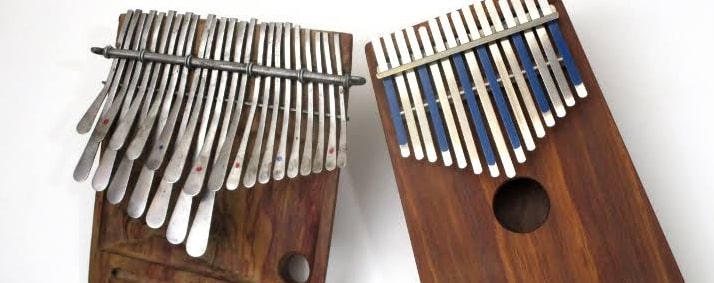Table of Contents
The Mbira is an African musical instrument, traditional to the Shona people of Zimbabwe. It consists of a wooden board (often fitted with a resonator) with attached staggered metal tines, played by holding the instrument in the hands and plucking the tines with the thumbs (at minimum), the right forefinger (most mbira), and sometimes the left forefinger.
Musicologists classify it as a lamellaphone, part of the plucked idiophone family of musical instruments. In Eastern and Southern Africa, there are many kinds of that, often accompanied by the hosho, a percussion instrument. It is often an important instrument played at religious ceremonies, weddings, and other social gatherings.
Though an ancient instrument, it was commercially produced and exported by ethnomusicologist Hugh Tracey from the 1950s onward, popularizing the instrument outside Africa; Tracey’s design was modeled after the mbira nyunga nyunga.
It became popularized largely due to the success of Thomas Mapfumo in the 1980s, who included it on stage accompanying modern rock instruments such as electric guitar and bass, drum kit, and horns. Mapfumo’s arrangements included numerous songs directly drawn from the traditional mbira repertoire.
Other notable influencers bringing its music out of Africa are Dumisani Maraire, who brought marimba and kalimba music to the American Pacific Northwest; Ephat Mujuru, who was one of the pioneer teachers of mbira dzavadzimu in the US; the writings and recordings of Zimbabwean musicians made by Paul Berliner.
Mbira/Mbira Instrument
The Mbira is an instrument from the African continent. It is sometimes called the ‘thumb piano’ because it is played with the thumbs and one finger.
The mbira is made of 22 to 28 metal keys attached to a hardwood soundboard called the gwariva, usually placed inside a large gourd to amplify the sound.
The metal keys are plucked with both thumbs and the forefinger of the right hand. The thumbs pluck downward on the keys. The forefinger plucks upward from beneath the keys.
Shona Mbira
Traditionally, the keys were made from iron ore smelted from rocks. Today it is common for the keys to be made of recycled materials, such as sofa springs, car spokes, or cans. Other recycled items, such as shells, beads, and bottle caps, are attached to the soundboard to create a buzzing sound.
The mbira is found throughout the African continent, but it is associated most closely with the Shona people of Zimbabwe. The Shona have played the mbira for more than a thousand years.
It is mentioned in their literature and is a part of their worship and rituals. The Shona name for the instrument is mbira dzavadzimu, which means ‘mbira of the ancestors.’

The Mbira is played for important Shona ceremonies, such as the bira, an all-night spirit possession ceremony. For these ceremonies, the mbira is accompanied by hand-clapping, singing, and percussion instruments. The Shona believe that the music of the mbira connects them to their ancestors.
Mbira dzavadzimu
The Mbira dzavadzimu is a lamellaphone idiophone of the Zezuru Shona people of Zimbabwe. It is closely associated with traditional spirit possession ceremonies. These ceremonies, known as bira, are the primary context in which the mbira dzavadzimu is played, but it also has come to be incorporated in other settings more secular in nature.
In recent decades, this instrument has become the most widely known form of Zimbabwean lamellaphone. This rise to prominence is often associated with the surge in nationalism that led to the Zimbabwean independence struggle of the 1970s. Music played on the mbira dzavadzimu became a source of nationalistic pride and came to index indigenous identity.
The secularization and popularization of the mbira dzavadzimu continued after the independence movement as popular music groups began to incorporate traditional musical instruments and styles into contemporary musical forms. This synthesis of traditional and popular music was most notably done by Thomas Mapfumo.
As the focus of scholarly writings and recordings published by American ethnomusicologist Paul Berliner in the 1970s, the mbira dzavadzimu came to the attention of an international audience.
How to Make a Mbira?
From a design standpoint, three features help to distinguish this specific type of lamellaphone (plucked idiophone) from numerous others:
- a solid wood soundboard with a fingerhole drilled into its bottom right-hand corner;
- 22-28 metal (iron or brass) tongues/lamellae, and
- three ranks of tongues.
Among the eight dzavadzimu pictured on this page are found examples with 22, 24, and 28 keys. Each tongue is wider and thinner at its sounding end than at its anchored one. They are held in place with a metal pressure bar that exerts downward pressure on the keys against the thick top end of the board, serving as a backrest and a metal bridge.
This metal bridge rests vertically on the board, held in place by slots cut into the board’s sidewalls. The maker sets the downward pressure of the bar with wire (sometimes with nuts and bolts), which is threaded alternately around the bar and through holes in the soundboard before being pulled taut.

The playing end of each tongue is arched upward, but to a different degree depending on in which rank it is located. Some sort of device will be attached near the bottom of the board to contribute a background buzzing or rattling sound to the primary sound produced on the lamellae; two devices can be seen in the gallery of photos on this page (one incorporating metal beads, the other a metal sheet with loosely attached bottle caps).
Although not an integral part of the instrument itself, a mbira dzavadzimu is typically wedged into a deze, a large hemispheric gourd (can be made from fiberglass as well) resonator with bottle caps loosely attached around its rim (see detail photo). The resonator and its buzzing mechanism greatly increase the volume of the mbira dzavadzimu.
Mbira Definition
A hand-held African musical instrument consisting of a series of metal or wooden strips mounted on a soundboard and, often, having a resonator formed from a gourd: it is played by plucking the strips with the thumbs and forefingers. It is the middle of the night in the wilds of Zimbabwe.
You’ve been invited to attend a sacred ceremony. The dancing and costumes are fascinating and exotic. The Shona people gathered around you are chanting and meditating. Underneath it all, music is playing – music you’ve never heard before. It is bell-like, repetitious, rattling, buzzing, and strangely hypnotic. You’re listening to the mbira.
Kalimba vs Mbira
“Kalimba” and “mbira” are often used interchangeably to describe a kalimba or a mbira. It can be pretty confusing when learning about either of these African instruments and even more confusing when you’re trying to buy one. To ensure you have the best experience when shopping for your new kalimba at X8 Drums, we thought we’d talk a bit about why a kalimba is not a mbira.
The kalimba looks pretty similar to a mbira, and both instruments consist of a wooden soundboard with steel keys that players depress and release with their fingers to create a tranquil, bell-like sound. Despite these similarities, the kalimba and the mbira are not the same instruments. Even a kalimba tuned mbira is not the same as a kalimba, just in tune with it.
The kalimba is actually a smaller, modern version of the mbira, which dates back more than 1,000 years in Zimbabwe. The kalimba was created by Hugh Tracey in the 1960s. Tracey liked the sound of the mbiras he heard while living in what is now Zimbabwe but wanted to create an adaptation better suited for Western music.

While there are a few subtle differences between the kalimba and the mbila, including a double row of keys on the mbira and a single row of keys on the kalimba, the major difference between the two instruments is in their scales.
The kalimba features the seven-note diatonic scale used in traditional Western music while the non-western scale of the mbira features the same notes but not in the same order. Some notes may even be missing. Because of the kalimba’s diatonic scale, every two-note combination creates a diatonic interval, making it easy to create harmonies.
The kalimba also features a different percussive element. In place of the buzzers, the traditional kalimba features two holes at the bottom of the soundboard. If you wave your fingers in and out of the holes, you’ll get a “wa-wa” effect. However, like kalimbas used by many musicians in Africa, the kalimbas at X8 Drum’s feature buzzers to create the distinctive buzzing effect of the mbira.
FAQs
What is the difference between a kalimba and a mbira?
What is another name for the Sansa?
What is the Sansa used for?
Is Kalimba easy to learn?
What is the most popular African instrument?
- The Talking Drum.
- The Balafon.
- Shekere.
- Djembe/Jembe.
- Udu.
- Marimba.
- Algaita.
